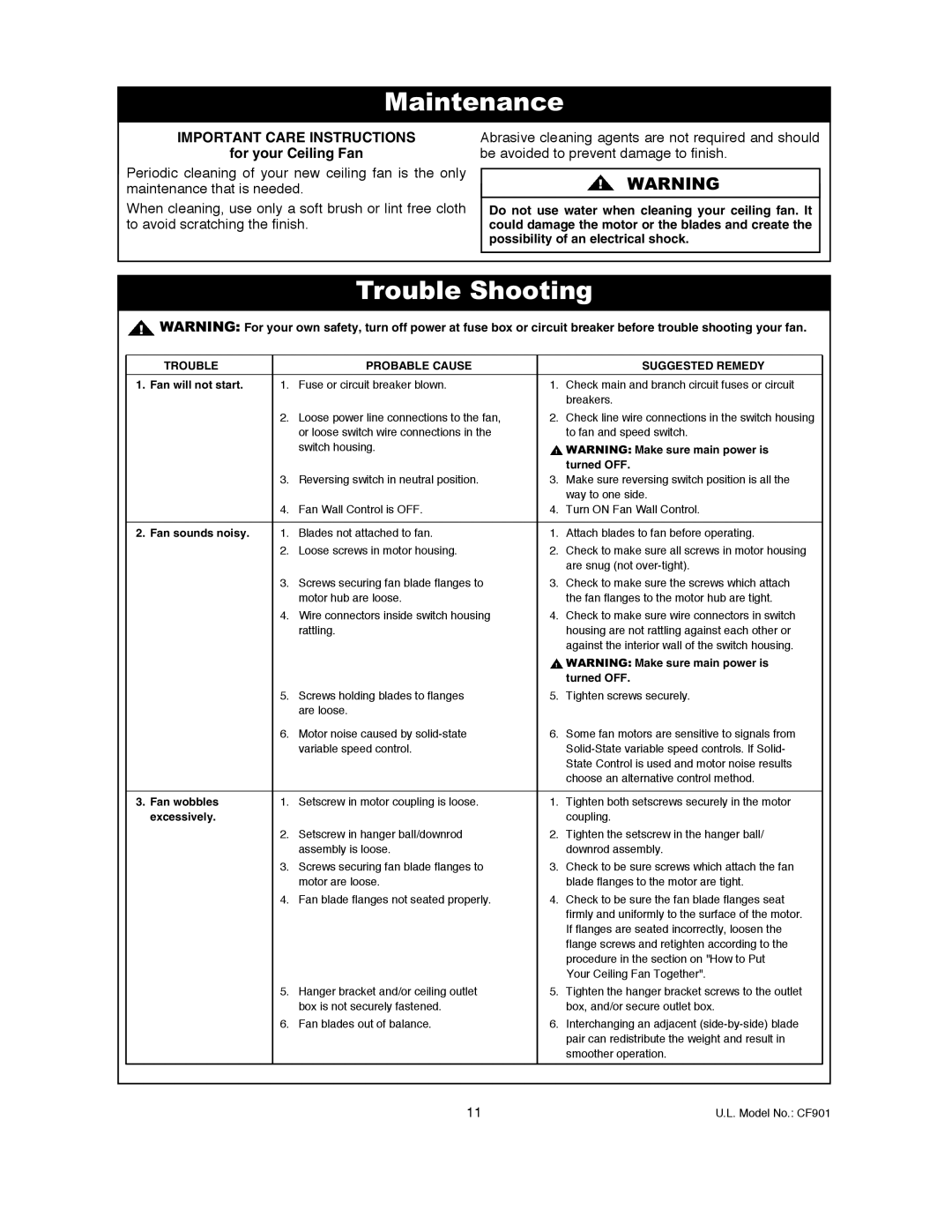
Maintenance
IMPORTANT CARE INSTRUCTIONS
for your Ceiling Fan
Periodic cleaning of your new ceiling fan is the only maintenance that is needed.
When cleaning, use only a soft brush or lint free cloth to avoid scratching the finish.
Abrasive cleaning agents are not required and should be avoided to prevent damage to finish.
!![]() WARNING
WARNING
Do not use water when cleaning your ceiling fan. It could damage the motor or the blades and create the possibility of an electrical shock.
Trouble Shooting
!![]() WARNING: For your own safety, turn off power at fuse box or circuit breaker before trouble shooting your fan.
WARNING: For your own safety, turn off power at fuse box or circuit breaker before trouble shooting your fan.
TROUBLE |
| PROBABLE CAUSE |
| SUGGESTED REMEDY |
|
|
|
|
|
1. Fan will not start. | 1. | Fuse or circuit breaker blown. | 1. | Check main and branch circuit fuses or circuit |
|
|
|
| breakers. |
| 2. | Loose power line connections to the fan, | 2. | Check line wire connections in the switch housing |
|
| or loose switch wire connections in the |
| to fan and speed switch. |
|
| switch housing. | ! | WARNING: Make sure main power is |
|
|
|
| turned OFF. |
| 3. | Reversing switch in neutral position. | 3. | Make sure reversing switch position is all the |
|
|
|
| way to one side. |
| 4. | Fan Wall Control is OFF. | 4. | Turn ON Fan Wall Control. |
|
|
|
|
|
2. Fan sounds noisy. | 1. | Blades not attached to fan. | 1. | Attach blades to fan before operating. |
| 2. | Loose screws in motor housing. | 2. | Check to make sure all screws in motor housing |
|
|
|
| are snug (not |
| 3. | Screws securing fan blade flanges to | 3. | Check to make sure the screws which attach |
|
| motor hub are loose. |
| the fan flanges to the motor hub are tight. |
| 4. | Wire connectors inside switch housing | 4. | Check to make sure wire connectors in switch |
|
| rattling. |
| housing are not rattling against each other or |
|
|
|
| against the interior wall of the switch housing. |
|
|
| ! | WARNING: Make sure main power is |
|
|
|
| turned OFF. |
| 5. | Screws holding blades to flanges | 5. | Tighten screws securely. |
|
| are loose. |
|
|
| 6. | Motor noise caused by | 6. | Some fan motors are sensitive to signals from |
|
| variable speed control. |
| |
|
|
|
| State Control is used and motor noise results |
|
|
|
| choose an alternative control method. |
|
|
|
|
|
3. Fan wobbles | 1. | Setscrew in motor coupling is loose. | 1. | Tighten both setscrews securely in the motor |
excessively. |
|
|
| coupling. |
| 2. | Setscrew in hanger ball/downrod | 2. | Tighten the setscrew in the hanger ball/ |
|
| assembly is loose. |
| downrod assembly. |
| 3. | Screws securing fan blade flanges to | 3. | Check to be sure screws which attach the fan |
|
| motor are loose. |
| blade flanges to the motor are tight. |
| 4. | Fan blade flanges not seated properly. | 4. | Check to be sure the fan blade flanges seat |
|
|
|
| firmly and uniformly to the surface of the motor. |
|
|
|
| If flanges are seated incorrectly, loosen the |
|
|
|
| flange screws and retighten according to the |
|
|
|
| procedure in the section on "How to Put |
|
|
|
| Your Ceiling Fan Together". |
| 5. | Hanger bracket and/or ceiling outlet | 5. | Tighten the hanger bracket screws to the outlet |
|
| box is not securely fastened. |
| box, and/or secure outlet box. |
| 6. | Fan blades out of balance. | 6. | Interchanging an adjacent |
|
|
|
| pair can redistribute the weight and result in |
|
|
|
| smoother operation. |
|
|
|
|
|
11 | U.L. Model No.: CF901 |
